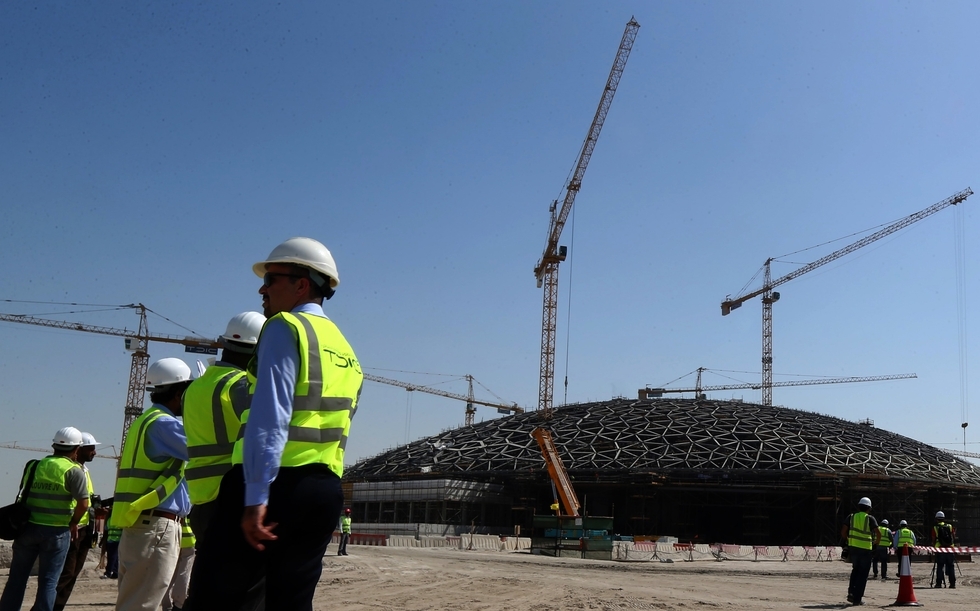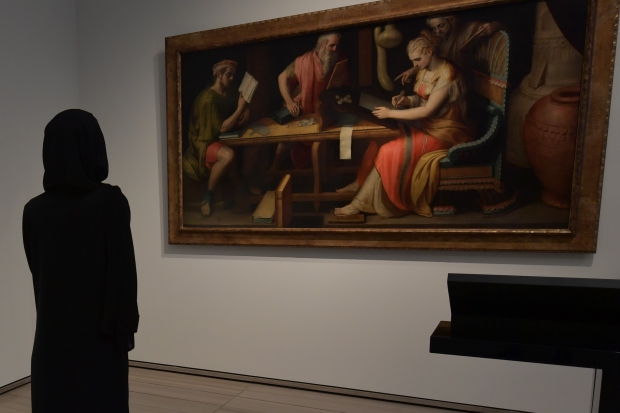Louvre Abu Dhabi: A memorial to forced labour?

The opening of the Louvre Abu Dhabi (LAD) is being heralded by its designer, Jean Nouvel, Agence France-Muséums, and the Abu Dhabi dominated UAE as a special feat as well as a triumphant cultural symbol; the region's first 'universal museum'.
No doubt it is an architectural and engineering achievement, but can or should a cultural institution of this kind, in particular, be built under conditions of forced labour in 2017?
The Louvre's brand name was worth less than half the overall contract for loans, expert advice and training
What is the over-riding symbolism or legacy in such a case?
Appalling conditions
LAD is a lynchpin in the development of the 27 square kilometres of Saadiyat Island, located opposite Abu Dhabi's naval port and capital city. It is, famously, one of the "starchitect"-designed cultural institutions unveiled in 2007 for Saadiyat, a cultural cherry on top of a neoliberal cake with boutique retail, hotels and villas.
The labour camp housing some of those building much of it is at the island's remotest tip.
Saadiyat is an important element in Abu Dhabi's laudable plans for a post-oil economy, in which glossy publicity has been crucial in nurturing high-spending tourism-to-come.
The architect of LAD, Jean Nouvel, has always been a doughty self-publicist, lavishing extravagant praise on the "symbolic and even … spiritual meaning" of his project, with slavish media support.
The thousands of men who made this possible, who deployed the exactitude with their bodies and hands, were migrant construction workers entrapped by worthless contracts
LAD includes 55 structures under a striking 180-metre-wide latticed dome, and has a 100-year engineering life. The plans and imagery of its completed form present a remarkable building of high aesthetic achievement.
The long-delayed opening was a consequence of exacting construction standards, not least for the storing and transporting of global treasure below sea level.
The problem is simple; the thousands of men who made this possible, who deployed the exactitude with their bodies and hands, were migrant construction workers entrapped by worthless contracts and recruitment debts, then forced to live under often appalling conditions.
These facts are not disputed; even government-paid monitors reported in mid-construction that 86 percent of workers carried recruitment debts, while officials insisted that all their workers do, even if some claimed otherwise.
Despite the outlawing of such practices by a ministerial decree and specific regulations for Saadiyat, no workers had been reimbursed.
Modern-day slavery
Nouvel claims to have checked conditions that south Asian men live and work under and saw "nothing" of concern. He now refers to evidence of modern-day slavery as an "old question". Perhaps he hasn't bothered with the monitor's reports, or visited the labour camps encircling Abu Dhabi, or massed at Jebel Ali or Al Quoz in the heart of Dubai.
In these camps, you will hear testimony in many languages detailing cruel hours, violent working conditions, real entrapment by debt, and fear about raising voices in a country that violently suppresses and deports any collective attempts to do so.
Testimony like this contributed to the ILO complaint about forced labour in Abu Dhabi which generated minor law changes in 2016. The Gulf Labour Coalition formed after a significant body of artists from the region protested to the Guggenheim about its exploitative approach to museum-building.
Anyone willing or able to articulate these abuses has been banned or deported while similarly 'awkward' Emiratis remain imprisoned indefinitely by the regime
The Frank Gehry-designed Guggenheim Abu Dhabi also began laying massive foundations and infrastructure in 2010 but remains years from completion.
Gulf Labour maintains an online archive of continuing research, activism and publications, triggered by the Guggenheim's refusal to engage the issue except as public relations.
While the Guggenheim trumpeted condescending claims about their prospective cultural transformation of the region, the British Museum's eight-year-long participation in planning the Norman Foster-designed Zayed National Museum has stalled after plans to loan a package of regional artefacts, including Assyrian reliefs, at very lucrative rates were announced in 2015.
I mention these institutions to contextualise the stunning deal made by the Louvre as part of a broader refinancing of western cultural brands.
The men who built the Louvre Abu Dhabi did so with an average recruitment debt of $2000 which took an average of two years to repay. Only then can they make their strategic sacrifice meaningful, and start to receive some of what they signed up for.
Gulf Labour last met with government officials at Saadiyat in 2014 - four of us present have since become "security threats"; banned or deported.
A series of UAE decrees between 1989 and 2015 require contractors to reimburse recruitment and travel costs but officials professed helplessness, despite Abu Dhabi's government having a controlling interest in Arabtec, who won the $653m contract to build the Louvre.
The Louvre's brand
Gulf Labour suggested that they reimburse the average debt of the men building LAD. Their number varied from 5-7000, so the cost of implementing Abu Dhabi’s own decrees would be up to $14m. Gulf Labour also suggested that beneficiary brands should contribute part of their "gold" to this solution.
The Louvre had the unique decency to publish its contract with Abu Dhabi. So we know that it rented its brand to Abu Dhabi in 2007 for $400m (or $520m) over 30 years, at which point the museum reverts to Abu Dhabi's control.
The Louvre's brand name was worth less than half the overall contract for loans, expert advice and training.
Recruitment debt is the key element in locking down conditions of forced labour, especially when there is no right to unionise or protest. Instead of seeing and doing "nothing", the Louvre could have easily broken these chains.
Nouvel's "old question" is an enduring one, made indelible by his elegant spectacle on Saadiyat Island.
The Louvre and Abu Dhabi had an opportunity to mark a bold cultural shift in built form but chose to memorialise forced labour instead. So when you see the ubiquitous imagery or visit Saadiyat, don’t forget the hands that made it possible, because you will see no trace of them nor hear any critique.
Anyone willing or able to articulate these abuses has been banned or deported while similarly "awkward" Emiratis remain imprisoned indefinitely by the regime.
- Guy Mannes-Abbott is a London-based writer whose work often performs in visual art contexts, including his highly-acclaimed In Ramallah, Running (London 2012), contributory texts for e-flux journal’s Supercommunity project (Venice Biennale 2015) and End Note(s) (Rotterdam/Hong Kong 2015). He contributed to The Gulf: High Culture, Hard Labor (New York 2015), participated in Moderation[s] at Witte de With (Rotterdam 2013) and collaborated with CAMP on The Country of the Blind, and Other Stories (Folkestone 2011). He tweets @guymannesabbott
Photo: This file photo taken on 21 October 2014 shows workers and journalists standing near the Louvre museum on Saadiyat island, near Abu Dhabi. More than a decade in the making, the Louvre Abu Dhabi opens its doors this week (AFP)
This article is available in French on Middle East Eye French edition.
New MEE newsletter: Jerusalem Dispatch
Sign up to get the latest insights and analysis on Israel-Palestine, alongside Turkey Unpacked and other MEE newsletters
Middle East Eye delivers independent and unrivalled coverage and analysis of the Middle East, North Africa and beyond. To learn more about republishing this content and the associated fees, please fill out this form. More about MEE can be found here.






